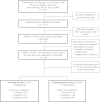Quitline cessation counseling for young adult smokers: a randomized clinical trial
- PMID: 23080378
- PMCID: PMC3621584
- DOI: 10.1093/ntr/nts227
Quitline cessation counseling for young adult smokers: a randomized clinical trial
Abstract
Introduction: One in 5 young adults in the United States currently smoke, and young adults are less likely than other smokers to make aided quit attempts. Telephone quitlines may be a useful tool for treating this population. This study tested a quitline-based smoking cessation intervention versus mailed self-help materials in smokers 18-24 years old.
Methods: This was a 2-group randomized clinical trial. The quitline-based counseling intervention (CI) included up to 4 proactive telephone counseling sessions; participants in the self-help (SH) group received only mailed cessation materials. Participants included 410 young adults who had smoked at least 1 cigarette in the past 30 days and who called the Wisconsin Tobacco Quit Line (WTQL) for help with quitting. Primary study outcomes included whether or not a quit date was set, whether or not a serious quit attempt was undertaken, and self-reported 7-day point-prevalence abstinence at 1-, 3-, and 6-month postenrollment.
Results: The CI and SH groups did not differ in the intent-to-treat abstinence analyses at any of the follow-ups. However, the CI group was significantly more likely to set a quit date at 1-month postenrollment. Follow-up response rates were low (67.8% at 1 month; 53.4% at 3 months; and 48.3% at 6 months) reflecting lower motivation to participate in this kind of research.
Conclusions: Relative to self-help, quitline counseling motivated young adults to set a quit date but abstinence rates were not improved. Research is needed on how to motivate young adult smokers to seek cessation treatment including quitline services.
Figures
References
-
- An L. C., Klatt C., Perry C. L., et al. (2008). The RealU online cessation intervention for college smokers: A randomized controlled trial. American Journal of Preventive Medicine, 47(2), 194–199 doi:10.1016/j.ypmed.2008.04.011 - PubMed
-
- Barnes S. A., Larsen M. D., Schroeder D. R., Hanson A., Decker P. A. (2010). Missing data assumptions and methods in a smoking cessation study. Addiction, 105, 431–437 doi:10.1111/j.1360-0443.2009.02809.x - PubMed
Publication types
MeSH terms
Grants and funding
LinkOut - more resources
Full Text Sources
Medical
Miscellaneous


